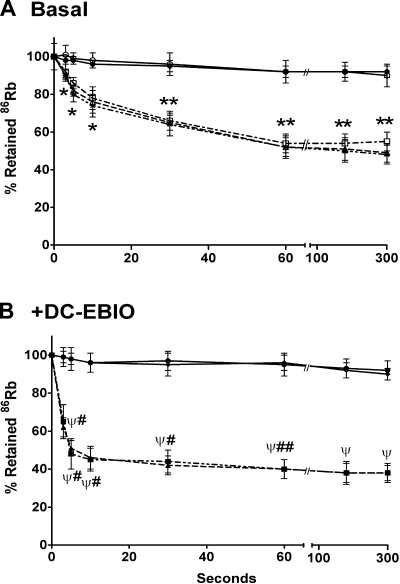Fig. 5.
Time course of 86Rb efflux in KCNN4 isoform-specific cRNA-injected oocytes. 86Rb loading and effluxes were performed as described in materials and methods. A: basal 86Rb effluxes were measured by placing the oocytes in K+-free medium. Under basal conditions, oocytes injected with cRNA for KCNN4b (open triangles), KCNN4c + BKβ1 (open squares), and KCNN4b + KCNN4c (stars) exhibited a low but significant rate of 86Rb effluxes and reached equilibrium at 1 min. 86Rb effluxes were very low in PBS- (open circles) and cRNA of BKβ1- (closed circles) injected oocytes. *P < 0.05 compared with respective time point in PBS/BKβ1-injected oocytes; **P < 0.001 compared with respective time point in PBS-injected oocytes. B: 5,6-dichloro-1-ethyl-1,3-dihydro-2H-benzimidazole-2-one (DC-EBIO)-enhanced 86Rb effluxes were measured by placing the oocytes in K+-free medium containing 100 μM DC-EBIO. The presence of DC-EBIO greatly enhanced the initial rate of 86Rb effluxes in both KCNN4b (closed squares) and KCNN4c + BKβ1 (closed triangles) cRNA-injected oocytes and reached equilibrium within 1 min. 86Rb effluxes were not significantly altered by DC-EBIO in PBS (closed circles) and cRNA of BKβ1 (closed diamonds) injected oocytes. ΨP < 0.001 compared with respective time point in PBS/BKβ1-injected oocytes; #P < 0.001 compared with respective time point in Fig. 6A; ##P < 0.05 compared with respective time point in Fig. 6A.

